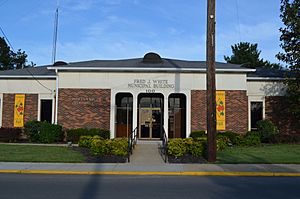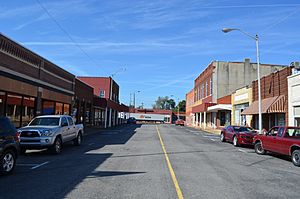Portland, Tennessee facts for kids
Quick facts for kids
Portland, Tennessee
|
|||
|---|---|---|---|

Portland City Hall
|
|||
|
|||

Location of Portland in Sumner County, Tennessee.
|
|||
| Country | United States | ||
| State | Tennessee | ||
| Counties | Sumner, Robertson | ||
| Established | 1859 | ||
| Incorporated | 1905 | ||
| Area | |||
| • Total | 14.82 sq mi (38.39 km2) | ||
| • Land | 14.80 sq mi (38.34 km2) | ||
| • Water | 0.02 sq mi (0.05 km2) | ||
| Elevation | 801 ft (244 m) | ||
| Population
(2020)
|
|||
| • Total | 13,156 | ||
| • Density | 888.74/sq mi (343.14/km2) | ||
| Time zone | UTC-6 (Central (CST)) | ||
| • Summer (DST) | UTC-5 (CDT) | ||
| ZIP code |
37148
|
||
| Area code(s) | 615/629 | ||
| FIPS code | 47-60280 | ||
| GNIS feature ID | 1298281 | ||
| Website | www.cityofportlandtn.gov | ||
Portland is a city in Tennessee, located in both Sumner and Robertson counties. In 2020, about 13,156 people lived there. Portland is also part of the larger Nashville Metropolitan Statistical Area.
Contents
History of Portland
Portland is found in the northern part of Middle Tennessee, on a raised area called the Highland Rim. This area has always been known for its rich farming soil, amazing wildlife, and pleasant weather.
Early Settlements and Tobacco Farming
People were first drawn to the Highland Rim from Virginia and the Carolinas. They came to buy land and grow a special type of dark tobacco. The climate and soil here were perfect for this crop. Growing dark tobacco made the land more valuable, which was good for land buyers. While many buyers moved on, the farmers stayed.
The oldest settlement near Portland is Fountain Head, started in 1792 by the James Gwin family. Over time, it grew to include a mill, a tobacco factory, a post office, a train station, and several shops.
How Portland Grew and Got Its Name
A school built by William Nolan helped the community grow. The area was first called Richland. In 1859, the Louisville and Nashville Railroad opened a route through Richland. A train station was built on land owned by Thomas Buntin, who became the first station agent and postmaster. This station helped the village develop, and even today, the railroad runs right through the center of town.
The first public high school in Sumner County started as a seminary in 1874. It later became Sumner County High School in 1915.
In 1887, there were two towns named Richland in Tennessee. To avoid confusion with train telegraphs and mail, officials decided to rename Richland in Sumner County. On April 10, 1888, it became Portland. The city was officially made a city in April 1904 by the Tennessee Assembly.
Modern Growth and Businesses
In recent years, Portland has been growing quickly. This is partly because of the growth of the Nashville area nearby. Several companies have their offices or factories in Portland, including Daido America, Kyowa America, and Unipres.
Geography and Climate
Portland covers about 11.4 square miles (29.5 square kilometers) of land. Only a very small part of the city is water.
Portland is the northern end point for U.S. Bicycle Route 23, a special path for bikes. The city is also known as the "strawberry capital of Tennessee" because of its strawberry farms.
Weather in Portland
| Climate data for Portland Sewage Plant, Tennessee (1991–2020 normals, extremes 1955–present) | |||||||||||||
|---|---|---|---|---|---|---|---|---|---|---|---|---|---|
| Month | Jan | Feb | Mar | Apr | May | Jun | Jul | Aug | Sep | Oct | Nov | Dec | Year |
| Record high °F (°C) | 72 (22) |
81 (27) |
85 (29) |
89 (32) |
94 (34) |
106 (41) |
105 (41) |
105 (41) |
100 (38) |
95 (35) |
86 (30) |
76 (24) |
106 (41) |
| Mean daily maximum °F (°C) | 45.3 (7.4) |
50.3 (10.2) |
59.1 (15.1) |
69.8 (21.0) |
77.7 (25.4) |
85.3 (29.6) |
88.8 (31.6) |
88.1 (31.2) |
82.2 (27.9) |
71.4 (21.9) |
58.9 (14.9) |
48.9 (9.4) |
68.8 (20.4) |
| Daily mean °F (°C) | 36.0 (2.2) |
39.9 (4.4) |
48.1 (8.9) |
58.2 (14.6) |
67.2 (19.6) |
75.1 (23.9) |
78.6 (25.9) |
77.5 (25.3) |
70.9 (21.6) |
59.7 (15.4) |
48.2 (9.0) |
39.6 (4.2) |
58.3 (14.6) |
| Mean daily minimum °F (°C) | 26.6 (−3.0) |
29.5 (−1.4) |
37.0 (2.8) |
46.5 (8.1) |
56.6 (13.7) |
64.8 (18.2) |
68.5 (20.3) |
66.9 (19.4) |
59.6 (15.3) |
47.9 (8.8) |
37.4 (3.0) |
30.2 (−1.0) |
47.6 (8.7) |
| Record low °F (°C) | −19 (−28) |
−9 (−23) |
−1 (−18) |
21 (−6) |
29 (−2) |
36 (2) |
48 (9) |
44 (7) |
32 (0) |
22 (−6) |
9 (−13) |
−14 (−26) |
−19 (−28) |
| Average precipitation inches (mm) | 4.20 (107) |
4.69 (119) |
5.08 (129) |
5.24 (133) |
5.80 (147) |
4.36 (111) |
4.57 (116) |
4.15 (105) |
3.64 (92) |
3.69 (94) |
3.78 (96) |
5.11 (130) |
54.31 (1,379) |
| Average snowfall inches (cm) | 0.2 (0.51) |
1.5 (3.8) |
0.3 (0.76) |
0.0 (0.0) |
0.0 (0.0) |
0.0 (0.0) |
0.0 (0.0) |
0.0 (0.0) |
0.0 (0.0) |
0.0 (0.0) |
0.0 (0.0) |
0.0 (0.0) |
2.0 (5.1) |
| Average precipitation days (≥ 0.01 in) | 10.9 | 9.9 | 12.4 | 10.9 | 11.0 | 10.3 | 9.7 | 7.9 | 7.8 | 8.0 | 8.8 | 11.3 | 118.9 |
| Average snowy days (≥ 0.1 in) | 0.5 | 0.9 | 0.2 | 0.0 | 0.0 | 0.0 | 0.0 | 0.0 | 0.0 | 0.0 | 0.1 | 0.2 | 1.9 |
| Source: NOAA | |||||||||||||
Population of Portland
| Historical population | |||
|---|---|---|---|
| Census | Pop. | %± | |
| 1910 | 579 | — | |
| 1920 | 869 | 50.1% | |
| 1930 | 1,030 | 18.5% | |
| 1940 | 1,212 | 17.7% | |
| 1950 | 1,660 | 37.0% | |
| 1960 | 2,424 | 46.0% | |
| 1970 | 2,872 | 18.5% | |
| 1980 | 4,030 | 40.3% | |
| 1990 | 5,165 | 28.2% | |
| 2000 | 8,458 | 63.8% | |
| 2010 | 11,480 | 35.7% | |
| 2020 | 13,156 | 14.6% | |
| Sources: | |||
Population in 2020
In 2020, the 2020 United States census counted 13,156 people living in Portland. There were 4,469 households and 3,247 families.
| Race | Number | Percentage |
|---|---|---|
| White (non-Hispanic) | 10,827 | 82.3% |
| Black or African American (non-Hispanic) | 603 | 4.58% |
| Native American | 35 | 0.27% |
| Asian | 70 | 0.53% |
| Pacific Islander | 2 | 0.02% |
| Other/Mixed | 664 | 5.05% |
| Hispanic or Latino | 955 | 7.26% |
Population in 2010
According to the 2010 Census, Portland had 11,480 people. Most of the population (90.5%) was non-Hispanic white. Other groups included 3.5% Black or African American, 0.3% Native American, 0.5% Asian, and 3.9% Hispanic or Latino.
Famous People from Portland
- Corey Brewer – A former professional basketball player in the NBA. He was born and grew up in Portland.
- Ronnie McDowell – A country music star who was also born and raised in Portland.
- Steve-O – A stunt performer known for the TV show Jackass.
Nearby Towns and Cities
- Nashville
- Hendersonville
- Gallatin
- White House
- Mt. Juliet
- Clarksville
- Westmoreland
- Orlinda
- Mitchellville
- Franklin
- Fairfield
- Oak Grove
- Bethpage
See also
 In Spanish: Portland (Tennessee) para niños
In Spanish: Portland (Tennessee) para niños




